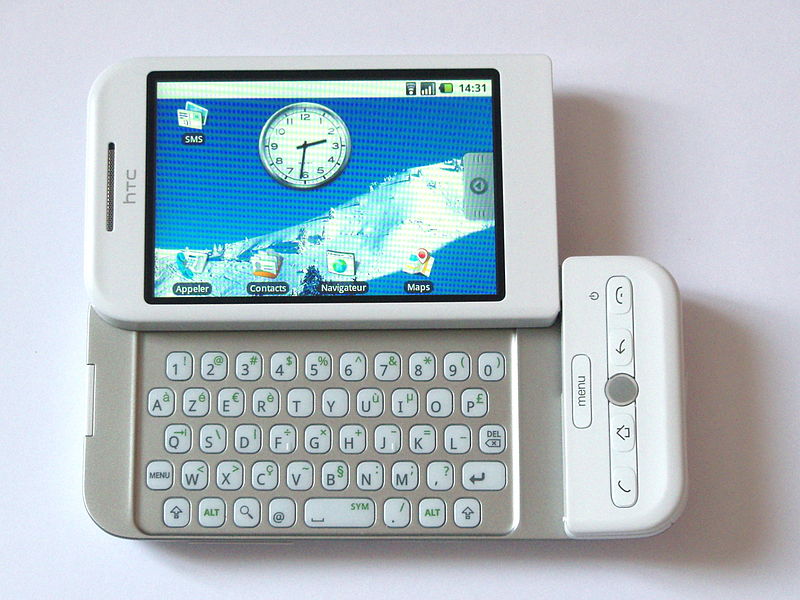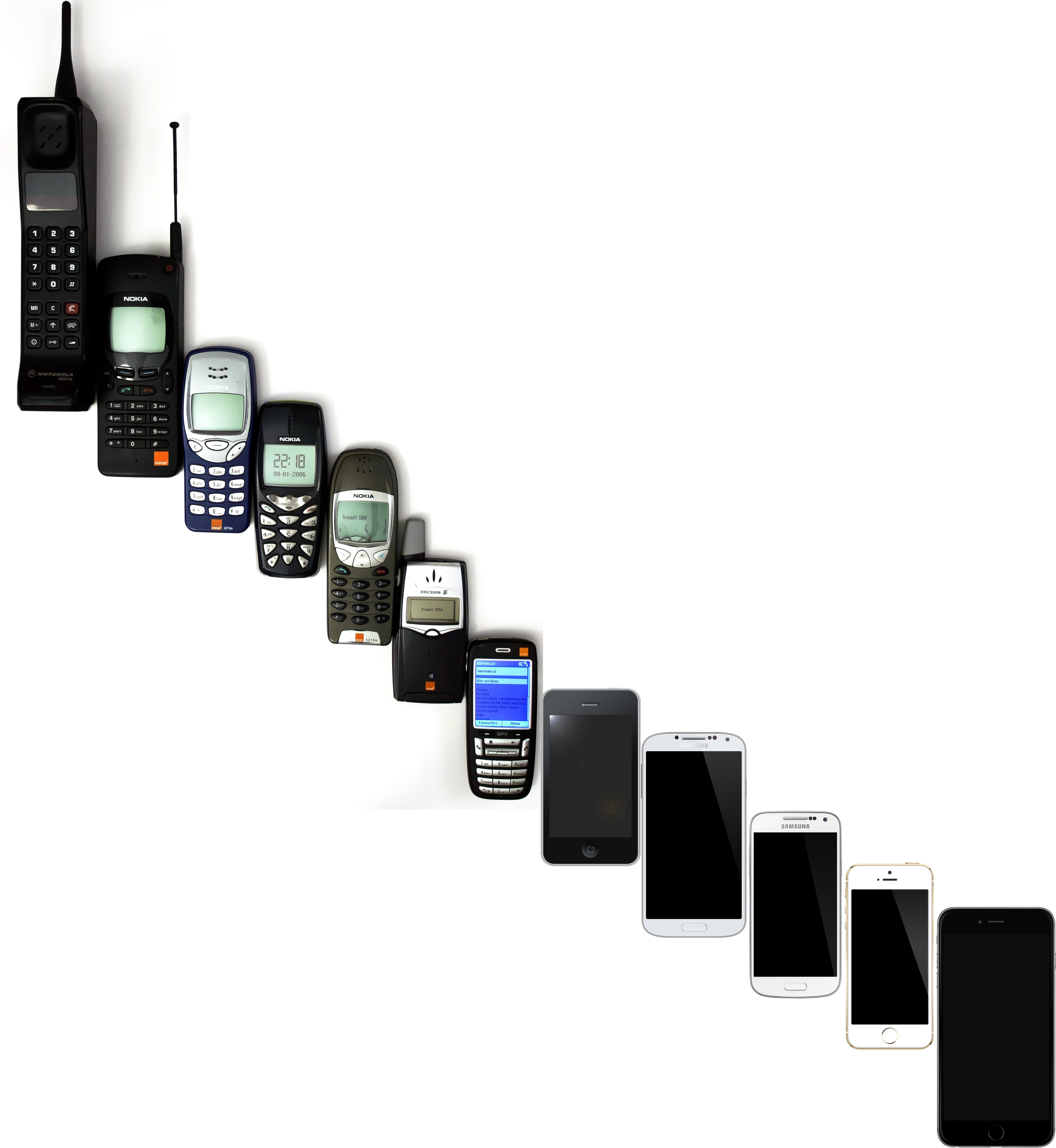Android 1.0's release marked the inception of the Android operating system, introducing fundamental functionalities like email support, web browsing, and a camera interface. Despite its relatively basic features compared to contemporary standards, it laid the groundwork for Google's mobile operating system, pioneering the way for modern smartphone experiences.

December 22, 2023
Android History from Android 1.0 to Android 14
Written by Marc Alringer
Overview
- Android is an incredibly adaptable operating system and has changed a lot from its original iteration, Android 1.0, to its modern version, Android 14.
- As the Android OS evolves, it changes the way we use our smartphones and devices.
- To date, there have been 22 Android releases, but we'll only be talking about the most significant ones in this article:
-
-
Android 1.0
-
Android 1.1
-
Android Cupcake
-
Android Donut
-
Android Eclair
-
Android Froyo
-
Android Gingerbread
-
Android Honeycomb
-
Android Ice Cream Sandwich
-
Android Jelly Bean
-
Android KitKat
-
Android Lollipop
-
Android Marshmallow
-
Android Nougat
-
Android Oreo
-
Android Pie
-
Android 10
-
Android 11
-
Android 12
-
Android 13
-
Android 14
-
- In the future, we'll see a lot of impressive technology, such as artificial intelligence handling user experiences, and biometric security features like retina scanning.
Time to read: 22 min
Android'S Revolutionary Approach
At its core, Android emerged in September 2008, introducing a revolutionary approach to mobile operating systems. With the release date of Android version 1.0, the foundation was laid for what would become a groundbreaking journey through numerous iterations, each bringing forth advancements in functionality, design, and user experience.
The journey began with basic smartphone functionalities on the HTC Dream, paving the way for subsequent versions like Cupcake, Froyo, and Ice Cream Sandwich. These iterations introduced groundbreaking features, from an on-screen keyboard and widgets to support Adobe Flash and a unified interface for both smartphones and tablets.

This is the HTC Dream mobile phone with AZERTY keyboard for the French market. This was the first mobile phone using the Android operating system.
As Android matured, it evolved into versions like Lollipop, Marshmallow, and Nougat, each iteration refining the user interface, enhancing multitasking capabilities, and prioritizing aspects like battery life and user privacy. Later iterations such as Oreo, Pie, and Android 10 underscored the importance of customization, privacy controls, and a seamless user experience across devices.
The recent chapters of Android history include Android 11 and the visually striking Android 12, which have spotlighted the significance of streamlined communication, refined privacy features, and a more personalized experience through design language enhancements.
As the Android saga continues with the unveiling of Android 14, this article takes a deep dive into the rich tapestry of Android history. From its formative years to cutting-edge advancements, join us on a journey through the milestones and innovations that have defined the evolution of Android, reshaping the way we interact with our digital world.
Who are We? Mobile App Development Masters
- At Seamgen, we develop groundbreaking mobile apps for a variety of healthcare, entertainment, and Fortune 500 clients, including federal and state governments.
- Over a decade of experience in agile software development methodologies leads to robust, innovative apps with a multitude of use cases.
- Several teams collaborate to deliver bug-free mobile apps.
- USA Design Led Development Agency based in San Diego, CA.
- We invite you to call us for a free project consulation.
Life Before Android
Before Android's revolutionary entry into the mobile ecosystem, the landscape of handheld devices was largely dominated by a myriad of proprietary operating systems. This era was characterized by a diverse range of mobile platforms, each tightly integrated with specific hardware and offering limited interoperability across devices.

Operating systems like Symbian, developed primarily by Nokia, held a dominant position in the market. Known for its reliability and widespread usage, Symbian powered a plethora of Nokia devices and offered a range of applications and functionalities for users. Meanwhile, BlackBerry OS catered to business professionals with its robust email and messaging capabilities, earning a reputation for secure communication.
Microsoft's Windows Mobile operating system was another notable player, providing a familiar Windows-like experience on mobile devices. It offered a range of productivity tools and paved the way for a more seamless integration between desktop and mobile computing.
In the pre-Android era, Apple's iOS emerged as a game-changer with the introduction of the iPhone in 2007. iOS set a new standard for user interface design, app ecosystems, and touch-based interactions on mobile phones, revolutionizing the smartphone industry. However, iOS remained exclusive to Apple devices, limiting its reach to a select user base.

This is an image of the 1st generation iPhone.
Amidst this diverse landscape, the absence of a unified, open-source platform meant limited innovation and interoperability across devices. Fragmentation in the market led to siloed experiences, restricting users to the features and functionalities offered by specific operating systems.
The mobile industry was ripe for disruption, yearning for a platform that could democratize access to cutting-edge technology, foster innovation among developers, and provide users with a consistent and adaptable mobile experience across various devices. This landscape laid the groundwork for the eventual emergence of Android, which would redefine the concept of mobile operating systems and democratize the smartphone landscape.

Marc Alringer
President/Founder, Seamgen
Marc Alringer, the visionary President and Founder of Seamgen, has been at the forefront of digital transformations, specializing in web and mobile app design and development. A proud alumnus of the University of Southern California (USC) with a background in Biomedical and Electrical Engineering, Marc has been instrumental in establishing Seamgen as San Diego's top custom application development company. With a rich history of partnering with Fortune 500 companies, startups, and fast-growth midsize firms, Marc's leadership has seen Seamgen receive accolades such as the Inc 5000 and San Diego Business Journal’s “Fastest Growing Private Companies”. His expertise spans a wide range of technologies, from cloud architecture with partners like Microsoft and Amazon AWS, to mobile app development across platforms like iOS and Android. Marc's dedication to excellence is evident in Seamgen's impressive clientele, which includes giants like Kia, Viasat, Coca Cola, and Oracle.
Android OS By Release
The evolution of Android has been a dynamic journey, marked by a series of transformative updates that have reshaped the landscape of mobile technology. Each iteration of the Android operating system represents a milestone in innovation, introducing new features, refining user experiences, and pushing the boundaries of what smartphones and devices can achieve.
This section serves as a comprehensive exploration of the various iterations of the Android operating system, from its inaugural release to the stable version to the latest advancements. Delving into the nuances of each version, we unveil the evolution of Android, chronicling the progression of functionalities, design philosophies, and user-centric enhancements that have defined each release.
From the foundational version of Android 1.0 to the latest iterations leading up to Android 14, this section provides an in-depth analysis of the key features, improvements, and technological advancements introduced with each update. Join us as we embark on a chronological journey through the evolution of Android, understanding how each iteration has contributed to shaping the modern smartphone experience.
Android 1.0
Marking the inception of the Android platform, version 1.0 debuted on the HTC Dream in September 2008, offering a pioneering glimpse into the world of mobile technology. This initial release laid the groundwork for modern smartphone experiences, introducing fundamental functionalities like email support, web browsing, and a camera interface.
Despite its relatively basic features compared to contemporary standards, the first full version of Android, version 1.0, was revolutionary for its time, establishing the foundation for Google's mobile operating system.
Android 1.5 Cupcake
Cupcake represented a significant leap forward, introducing a slew of new features that enhanced the user experience in April 2009. The update brought forth an on-screen keyboard, allowing users to type without relying on physical keyboards.
Additionally, Cupcake introduced widgets for the home screen, enabling personalized customization and easier access to information. This latest version of android also marked the introduction of video recording capabilities and the ability to upload videos to YouTube directly from the device home screen, expanding the phone's multimedia capabilities.
Android 2.2 Froyo
Froyo, short for Frozen Yogurt, was a pivotal update in Android history that introduced several key features, making Android more versatile and user-friendly in May 2010. Notable additions included support for Adobe Flash in the browser, enabling access to a wider range of web content. Froyo also introduced USB tethering and the option to install apps on the SD card, providing users with increased flexibility in managing device storage.
Android 4.0 Ice Cream Sandwich
Introduced in October 2011, Ice Cream Sandwich marked a major design overhaul, unifying the Android experience across both smartphones and tablets. The update introduced the visually appealing Material Design language, characterized by smoother animations, refined typography, and a cohesive visual style.
Alongside the aesthetic enhancements, Ice Cream Sandwich introduced features like Face Unlock for device security, resizable widgets, and an improved multitasking interface, elevating user interaction and device functionality.
Android 4.4 KitKat
The October 2013 introduction of KitKat focused on optimizing Android for devices with varying hardware capabilities. This new Android version aimed to make Android smoother and more efficient, particularly on devices with lower specifications. It introduced "OK Google" voice commands for hands-free operation and brought improvements to multitasking and responsiveness. KitKat's emphasis on performance optimization made it a significant step towards ensuring a consistent experience across a wider range of devices.
Android 5.0 Lollipop
Lollipop was a transformative update made in November 2014 that not only revamped the visual aesthetics but also brought substantial improvements in functionality. The introduction of Material Design brought a fresh, colorful and redesigned user interface, with smoother animations and a more intuitive user experience.
Beyond the visual overhaul, Lollipop introduced a host of features including a redesigned notification system with lock screen notifications, a battery-saving mode named Project Volta that extended device battery life, and enhancements to multitasking with the introduction of the Overview button, allowing easy access to recent apps.
Android 6.0 Marshmallow
Marshmallow continued the trend of refining the Android version in October 2015 by focusing on improving core functionalities. Noteworthy additions included granular app permissions, empowering users to control app permissions individually.
Google Now on Tap was introduced, offering contextual information based on the content displayed on the screen. Additionally, Marshmallow introduced a feature called Doze, which significantly improved battery life by putting the device into a deeper sleep state when idle, conserving power more efficiently.
Android 7.0 Nougat
Hitting the market in August 2016, Nougat aimed to enhance user productivity and convenience. The introduction of split-screen multitasking allowed users to run two apps simultaneously, fostering better multitasking capabilities and smarter mobile devices.
This update also revamped the notification system, introducing bundled notifications for easier management and quick replies directly from the notification shade. Furthermore, Nougat improved the Doze feature introduced in Marshmallow, optimizing the Android version further for better battery performance, even when the device was in motion.
Android 8.0 Oreo
August 2017's Android Oreo update focused on refining the user experience and optimizing system performance. It introduced Picture-in-Picture mode for enhanced multitasking, allowing users to watch videos while using other apps. Notification dots were introduced to easily identify which apps had notifications, and background app limitations were enforced for improved system stability and battery life. Additionally, Android Oreo brought in Autofill APIs for better password management across apps.
Android 9 Pie
The Android Pie update in August 2018 was centered around AI-driven enhancements and user well-being. It introduced gesture-based navigation, moving away from traditional navigation buttons. Adaptive Battery and Adaptive Brightness use machine learning to optimize battery life and display brightness according to individual user habits. Digital Wellbeing features provided insights into device usage habits, helping users manage their screen time and promoting a healthier relationship with technology.
Android 10
Android 10 brought a refined user experience with a strong focus on privacy and customization in September 2019. The introduction of a new operating system--wide dark mode provided users with a more comfortable viewing experience in low-light environments while conserving battery life on devices with OLED screens.
It revamped permissions, giving users more control over app permissions by allowing them to grant access on a per-use basis. Android version 10 also introduced a new gesture-based navigation system, replacing the traditional navigation buttons for a more intuitive and immersive interaction.
Android 11
Introduced in September 2020, and building upon the foundation laid by its predecessors, Android 11 aimed to streamline communication and enhance device control. The update focused on conversation organization within the notification shade, separating notification channels and prioritizing conversations from other notifications.
A built-in screen recording feature was introduced, allowing users to capture and share their screen activities. Android version 11 also reinforced user privacy with one-time permission grants for sensitive permissions like camera and microphone access.
Android 12
October 2021's stable version of Android 12 represented a significant visual overhaul, introducing a design language called Material You. This iteration prioritized personalization, allowing users to customize the system's color palette based on their wallpaper, creating a more cohesive and personalized experience.
This new Android version also introduced larger, more interactive widgets, enhancing the home screen's functionality and aesthetic appeal. Android 12 emphasized privacy with indicators that showed when the microphone or camera was being accessed by apps, enhancing transparency and control over app permissions.
Android 13
Android 13, released in August 2022, introduces a series of enhancements aimed at personalization, security updates, and device integration. Notable features include expanded app theming, allowing customization of non-Google apps to match the device's wallpaper theme and colors. Language settings per app enable users to assign specific languages to individual apps.
An updated media player adapts its appearance based on the music or podcast being played, spotlighting album artwork and altering the playback bar accordingly. Improvements in privacy include selective media library access for apps and automatic clipboard history clearing for sensitive data.
Additionally, Android version 13 enhances device synchronization, offering features like Spatial Audio, streaming messaging apps to Chromebook, Bluetooth Low Energy (LE) Audio, and seamless content copying and pasting between devices.
Tablet enhancements include an updated taskbar, improved multitasking, and distinguishing palm and stylus pen touches for fewer accidental marks. These upgrades aim to deliver a cohesive experience across devices, and the rollout commenced with Pixel devices and expanded to various other brands later that year.
Android 14
Android version 14, released in October 2023, introduces a myriad of customizable features and enhanced accessibility options. This update focuses on personalization, offering more ways to express individuality through AI-generated wallpapers, monochromatic themes, and curated lock screen templates. The Ultra HDR support enhances photo quality, delivering vibrant colors and refined contrasts.
Notably, Health Connect centralizes health data securely across multiple user accounts, while improved data-sharing controls grant users greater visibility and control over shared information. Security upgrades include encouraging six-digit PINs multiple user accounts and heightened magnifier settings for low-vision users.
Android OS accessibility enhancements extend to hearing aids and flash notifications for visual alerts. Android 14 is initially rolling out to Pixel devices, extending later to Samsung Galaxy, OnePlus, Sony, and other favored devices.
The evolution of Android showcases a continuous effort to refine user experiences, enhance privacy features, and offer greater personalization. Each iteration brings forth advancements in technology and user-centric enhancements, shaping Android into a versatile and user-friendly operating system.
Seamgen Pro Tip: We stay up-to-date with the latest technology trends, whether in mobile app development, AI or other emerging platforms, to keep client iOS and Android apps relevant and competitive. Click here for more about our custom mobile app development.
Android's Rivals From 2008 to Present
In the dynamic and fiercely competitive realm of mobile operating systems, Android has navigated a landscape teeming with formidable rivals, each vying for a prominent position in the evolving smartphone market. From its inception in 2008, Android has engaged in a continuous tussle for market dominance against a spectrum of compelling competitors, each wielding distinct strengths and strategies.

Mobile phone evolution, respectively, from left to right: Motorola 8900X-2, Nokia 2146 orange 5.1, Nokia 3210, Nokia 3510, Nokia 6210, Ericsson T39, HTC Typhoon, iPhone 3G, Samsung Galaxy S4, Samsung Galaxy S4 mini, iPhone 5s, iPhone 6 Plus
Mobile Evolution
by
Jojhnjoy
is licensed under
Public Domain
This section illuminates Android's journey amidst a backdrop of formidable adversaries, showcasing the pivotal competitors that shaped the mobile ecosystem alongside Android's ascendancy. From iOS's refined user experience and Apple's ecosystem exclusivity to the productivity-centric approach of Windows Mobile/Phone, the secure messaging prowess of BlackBerry OS/BlackBerry 10, and the once-dominant presence of Symbian, Android found itself entrenched in a landscape defined by diverse operating systems, each offering unique features and targeting distinct user demographics.
Exploring the evolution of Android's rivals from 2008 to the present day, this section provides insights into the competitive forces that have influenced Android's trajectory, contributed to technological innovation, and shaped the choices available to consumers in the ever-evolving world of mobile phones.
iOS (Apple)
Android's primary rival has been Apple's iOS. Launched in 2007 with the release date of first iPhone, iOS quickly gained prominence for its intuitive user interface, tight integration with Apple's hardware, and robust ecosystem of high-quality, curated apps. Known for its security measures and closed ecosystem, iOS offered a consistent and polished user experience across Apple devices, catering to a loyal user base seeking seamless integration between their devices.
Microsoft's Windows Mobile/Phone
Windows Mobile, later rebranded as Windows Phone, emerged as a competitor with Microsoft's approach to mobile operating systems. With a tiled interface and a focus on productivity, Windows Phone aimed to bridge the gap between desktop and mobile experiences. However, despite its innovative design and features, it struggled to gain significant market share and developer support, leading to its eventual decline.
BlackBerry OS/BlackBerry 10
BlackBerry OS held a stronghold in the market, especially among business users, for its secure messaging and email capabilities. However, as the smartphone landscape evolved, BlackBerry faced challenges adapting to touch-based interfaces and competing with the app ecosystems of iOS and other Android phones. BlackBerry 10 was an attempt to modernize the platform, introducing a more user-friendly interface, but it faced an uphill battle in regaining market share.
Symbian (Nokia)
Symbian, predominantly associated with Nokia devices, was a dominant force in the pre-smartphone era. It offered extensive customization options and a broad array of apps. However, its complex interface and the emergence of more user-friendly competitors like iOS and Android led to its eventual decline.
These competitors each brought unique strengths to the market, catering to different user preferences and needs. iOS, Windows Mobile/Phone, BlackBerry OS/BlackBerry 10, and Symbian were Android's notable rivals, each contributing to the diverse landscape of mobile operating systems.
The Future of Android and Smartphones: A Glimpse into 2024 and Beyond
The trajectory of Android's evolution hints at several potential directions and innovations that might shape its future, with the dynamic nature of technology suggesting areas where Android might continue to evolve. This includes enhanced AI integration, envisioning a deeper integration of artificial intelligence (AI) into the operating system. This could facilitate smarter and more contextually aware user experiences, potentially manifesting in AI-driven personal assistants, predictive functionalities, and improved automation across various aspects of device usage.
The future could also see Android optimizing its OS for foldable and flexible devices, seamlessly adapting to new form factors. As foldable and flexible display technology gains popularity, Android may refine its interface and functionalities, providing a more cohesive experience across a variety of foldable and dual-screen devices.
Moreover, the integration of augmented reality (AR) and virtual reality (VR) experiences is on the horizon. Android might deepen its support for these immersive technologies, involving optimizations for AR-enhanced applications, better hardware-software synergy for VR devices, and potentially introducing dedicated features tailored for AR/VR interactions.
Privacy and security are expected to remain at the forefront of Android's future iterations. Anticipated developments include more granular controls over data sharing, enhanced encryption methods, and additional measures to safeguard user information across the ecosystem.
Additionally, Android is likely to prioritize eco-friendly initiatives, aligning with the growing emphasis on sustainability. This could involve optimizations for energy efficiency to save battery life, promote the repairability and longevity of devices, and integrate features that encourage eco-conscious usage patterns.
Looking into the broader landscape of smartphones in 2024 and beyond, a transformative shift is anticipated. The resurgence of modular smartphones is foreseen, offering customization and upgradability, coupled with a strong focus on repairability to reduce electronic waste. Biometric advancements, including under-display fingerprint sensors and facial recognition, are poised to enhance security and convenience.
Smartphones are expected to evolve into comprehensive health monitoring devices, incorporating advanced sensors for real-time health insights and proactive wellness management. Holographic displays are envisioned to redefine user interaction, providing immersive experiences beyond traditional screens.
Artificial intelligence is set to play a crucial role in tailoring user experiences. By 2024, smartphones might leverage AI to anticipate user needs, offering highly personalized recommendations for apps, content, and services based on individual phone usage history, patterns, preferences, and context.
Moreover, environmental sensing and sustainability features are anticipated to be integral. Smartphones might integrate environmental sensors for measuring air quality, temperature, and assessing environmental impact. Manufacturers may implement sustainability-focused features, such as energy-saving modes, carbon footprint tracking, and the use of eco-friendly materials in device construction.
In this envisioned future, smartphones extend beyond communication and productivity, becoming central hubs in interconnected smart ecosystems. Acting as control centers for smart homes, IoT devices, and wearables, they facilitate seamless interaction and management of various connected devices.
The landscape of smartphones in 2024 and beyond represents boundless potential and transformative innovation. The convergence of technological advancements with environmental consciousness heralds a paradigm shift, transcending the conventional boundaries of smartphones. As we stand on the cusp of this technological revolution, the journey of smartphones serves as a testament to human ingenuity, pushing the boundaries of what's possible and shaping a future where our handheld companions are catalysts for a more connected, personalized, and sustainable world.
FREQUENTLY ASKED QUESTIONS (FAQ'S)
2
How did Android's evolution impact the smartphone landscape?
+
Android's evolution transformed the smartphone landscape by introducing diverse functionalities, design enhancements, and improved user experiences across various iterations. It expanded the capabilities of mobile devices, offering features like multitasking, customizable interfaces, refined security measures, and streamlined communication, redefining how users interact with smartphones.
3
What were the distinguishing features of Android versions like Cupcake, Froyo, and Ice Cream Sandwich?
+
Cupcake introduced an on-screen keyboard and widgets, Froyo brought Adobe Flash support and app installation on SD cards, while Ice Cream Sandwich unified the Android experience across smartphones and tablets with the visually appealing Material Design language and improved multitasking.
4
How did Android 12 differentiate itself visually from its predecessors?
+
Android 12 introduced Material You, a design language focusing on personalization. It allowed users to customize the system's color palette based on their wallpaper, introduced larger, more interactive widgets, and emphasized privacy with indicators showing when the microphone or camera was accessed by apps.
5
In what ways did Android revolutionize the mobile operating system market compared to its rivals, such as iOS, BlackBerry OS, and Windows Mobile/Phone?
+
Android revolutionized the market by offering an open-source platform, fostering innovation among developers, democratizing access to cutting-edge technology, and providing a consistent and adaptable mobile experience across various devices, unlike the more closed and exclusive ecosystems of its rivals.
6
What innovations in biometric authentication can we expect in future Android devices?
+
Future Android devices might adopt more advanced biometric authentication methods, such as under-display fingerprint sensors, facial recognition, or newer technologies like vein or retina scanning, enhancing security and convenience for users.

Written by
Chief Revenue Officer/Founder, Seamgen
I founded Seamgen, an award winning, San Diego web and mobile app design and development agency.

Do you need a premier custom software development partner?
Let’s discuss your modernization strategy and digital application goals.
Let's Connect
Up Next







